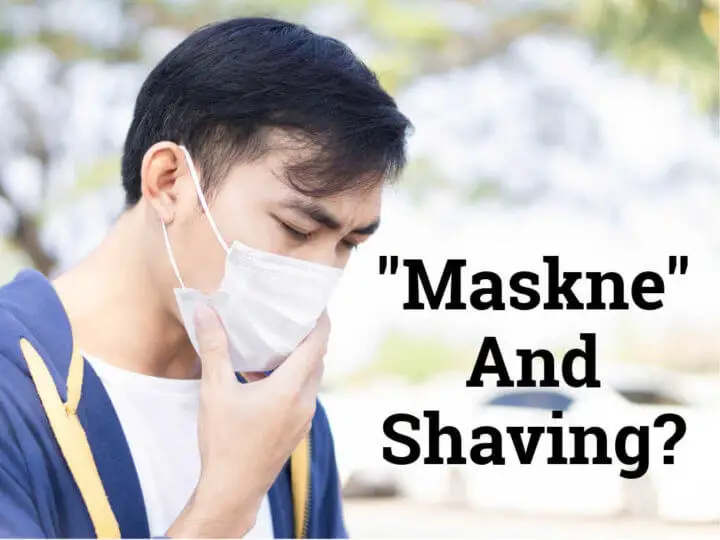
You are wearing a mask for long periods of time. And now your face is breaking out beneath the mask. Congratulations, you have “maskne.” Can shaving help or hurt the problem? Here is what to do about it.
What Is “Maskne?”
Maskne is really a form of Acne Mechanica – a combination of oil from the skin and rubbing from the mask for extended periods of time. Medical professionals, soldiers, and players of sports who have to wear helmets, chin guards, or even shoulder pads are probably already familiar with this kind of breakout.
When you breathe or talk in a mask, the mask tends to trap in hot air. That creates a warm, humid environment – an ideal setting for bacteria, yeast, and other flora from which to grow.
A mask can also cause irritation and a patch of rough, red skin similar to chafing.
People can also be allergic to the metal nose frame or to other materials in the face mask. You can also develop allergies to the detergent that is used to wash a cloth mask–in this case, the rash can itch and look more like eczema.
But there are products you can apply to treat maskne, and strategies you can employ to avoid getting it again.
How To Treat Maskne
To address maskne you already have, classic blemish spot treatments like those containing benzoyl peroxide, retinoids, and/or salicylic acid are the way to go. But these spot treatments can be very drying to your skin. Apply them gradually.
A gentle exfoliant and hydrator can help clear away the smaller particles that hang out on your face and clog your pores can help too. But doing this once a week is the most you should do.
Of course, if a breakout is severe or doesn’t go away with home treatment, see your family physician or a dermatologist to find out what’s going on.
How To Avoid Maskne
Wash your face twice a day, before and after wearing a mask, with a mild facial cleanser. After washing your face apply a light moisturizer to prevent dryness and repair the skin’s natural protective barrier.
Face Masks
Opt for a soft, silk or cotton mask (if possible, depending on your job) to reduce friction and irritation; rayon or polyester aren’t as gentle and can create more friction. Some fabrics are softer and more flexible than others so they may be more comfortable. Tight weave fabrics and masks with several layers offer better protection.
Wash your mask frequently (ideally, after every use. Or rotate between several masks). This will help remove any acne-causing bacteria and oils from the mask (and help prevent the spread of COVID-19 too). Use hot water, fragrance-free laundry detergent, and white vinegar (which has antibacterial, antiviral, and anti-fungal properties). Ideally, use a fragrance-free laundry detergent to reduce the possibility of irritation from fragrance ingredients. Don’t use a fabric softener when drying the mask in a dryer.
When exercising with a mask, sweat and friction are inevitable, so the key is to use a clean, dry mask every time. After your workout remove the mask (after washing your hands!) and wash your face.
The most important thing you can do when it comes to maskne is to pay attention to how your skin is reacting to wearing a mask. If you feel like moisture is building up under your mask or if your skin feels irritated or tender, step away from others, remove your mask, pat dry any moisture, and let your skin breathe for a few minutes.
Maskne And Shaving?
If you’ve got some facial hair you may be having problems with an inflammation or infection of the hair follicles, similar to razor bumps, beard folliculitis. This becomes an issue when short whiskers get caught in masks as facial hair grows out. To avoid it, go for an either/or approach: either let it grow out or shave close. It’s the five o’clock shadow (or not shaving during weekends) that may cause problems.
Conclusion
Current CDC guidelines recommend “wearing cloth face coverings in public settings where other social distancing measures are difficult to maintain.” But with the right mask and good grooming practices you can avoid mask-related skin problems.
Do you have any suggestions on how to avoid or treat maskne? Leave a comment!
